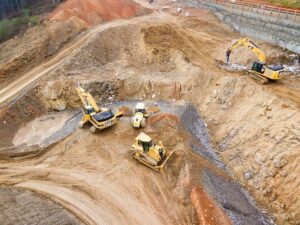Utility Construction Services in Kentucky: Comprehensive Solutions for Underground Infrastructure Installation and Management
Kentucky’s infrastructure network depends on expertly installed underground utilities to deliver water, sewer, gas, electricity, and telecommunications reliably across urban and rural areas. Utility construction contractor services combine precise excavation, trenchless technology, and civil works expertise to create seamless subsurface routes for essential services. This article clarifies the scope of underground utility construction, explains core installation methods, compares trenchless and traditional approaches, details Earth Works, LLC’s project management process, outlines Kentucky-specific regulations and safety standards, explores cost estimation factors, and highlights the civil works preparations that underpin successful service corridors. Whether you manage a commercial development or oversee a municipal upgrade, understanding these components will equip you to evaluate contractors, optimize budgets, and minimize surface disruption.
Expert Underground Utility Installation & Management in Kentucky
Utility construction services encompass the planning, excavation, installation, and restoration of underground infrastructure that supports water distribution, wastewater removal, natural gas transmission, electrical conduits, and fiber-optic cabling. By integrating civil works, mass earthwork, and precision trenching or trenchless methods, contractors ensure that service corridors meet regulatory standards, environmental safeguards, and client timelines. In Kentucky’s varied terrain—from urban Lexington streets to rural Elizabethtown subdivisions—reliable underground networks underpin residential growth, industrial expansion, and public utilities.
General contractors and project managers rely on utility construction expertise to integrate new developments or rehabilitate aging mains without compromising existing structures or roadways. Understanding how these systems come together leads directly into the specialized methods—like horizontal directional drilling and pipe bursting—that minimize disruption and optimize installation efficiency.
How Does Underground Utility Installation Work? Key Methods and Technologies Explained
Underground utility installation combines trenchless and open-cut techniques to embed pipes and cables beneath the surface. Horizontal directional drilling (HDD), pipe bursting, and moling are trenchless methods that reduce restoration and environmental impact, while traditional trench excavation remains essential for large-diameter installations or sites with complex soil conditions. Effective alignment, subsurface mapping, and specialized equipment selection form the basis of every successful project.
What Is Horizontal Directional Drilling (HDD) and How Is It Used in Kentucky?
Horizontal directional drilling installs conduits along a predetermined bore path by drilling pilot holes, enlarging the drill window, and pulling in pipe segments. This method avoids extensive surface trenches and is ideal for crossing highways, streams, and sensitive landscapes. In Kentucky, HDD supports water main extensions and fiber-optic networks beneath roadways with minimal road closures and restoration costs.
Horizontal Directional Drilling for Sewer Installation Beneath the Licking River, Kentucky
To reduce the annual overflow volume for the Sanitation District No. 1 of Northern Kentucky, a new 18-inch gravity siphon sewer was required to convey flow across (beneath) the Licking River in Wilder, Kentucky. The Licking River is a tributary of the Ohio River and is situated just south of Cincinnati. The width of the river at the location of the new siphon sewer crossing ranges from 300 to 400 feet, depending on the river level. Horizontal Directional Drilling (HDD) was the chosen construction method for the new
How Does Pipe Bursting Facilitate Efficient Utility Replacement?
Pipe bursting replaces existing pipelines by fracturing the old pipe while simultaneously pulling in a new high-density polyethylene pipe. This trenchless technique accelerates water and sewer main renewals with reduced excavation volumes, shortened project durations, and preserved surface features—crucial in downtown Frankfort and historic districts.
What Are the Benefits of Moling for Small Utility Installations?
Moling creates a narrow underground pilot hole using pneumatic impact, then expands it to pull in small-bore conduits such as electrical or telecom lines. This low-impact trenchless method accelerates installations in confined spaces, eliminates spoil removal, and limits surface disturbance in residential yards or narrow sidewalks.
When Is Traditional Trenching and Excavation Required?
Traditional trenching remains necessary when installing large-diameter pipes, performing deep utility swaps, or working in terrains with unpredictable geology. Open-cut excavation provides visual access for rock removal, bedding preparation, and comprehensive inspection. Projects with multiple overlapping utilities often combine trenchless and open-cut segments for optimal efficiency.
Below is a comparison of these core installation methods, their categories, key benefits, and typical applications in Kentucky projects.
What Are the Advantages of Trenchless Utility Solutions Compared to Traditional Methods?
Trenchless technology improves utility construction by reducing excavation volumes, accelerating installation schedules, and protecting surface features such as roadways, landscaping, and concrete structures. Minimal environmental disturbance and lower restoration requirements translate into faster site turnover and community goodwill.
Key advantages include:
- Enhanced project timelines through continuous boring and pipe-in-pipe operations
- Lower restoration and landscaping costs due to limited surface trenches
- Improved safety by keeping crews away from open-cut trenches
- Reduced soil disposal and erosion control measures
- Ability to navigate under obstacles without heavy machinery exposure
These benefits support both commercial and residential developments by optimizing budgets and maintaining ongoing site access, setting the stage for Earth Works, LLC’s efficient project execution process.
How Does Earth Works, LLC Manage Utility Construction Projects in Kentucky?
Earth Works, LLC applies a structured six-step process to ensure precision, safety, and on-budget delivery for every utility construction project. Their reliable team combines cutting-edge equipment with local expertise to handle residential subdivisions, commercial sites, and municipal works across Kentucky.
- Site Survey and Utility Locating – Subsurface mapping and conflict analysis guide service routing.
- Permitting and Regulatory Approval – Coordination with Kentucky agencies secures necessary authorizations.
- Equipment Mobilization – Advanced HDD rigs, pipe-bursting units, and excavators are deployed.
- Installation and Monitoring – Real-time data tracking ensures alignment, depth control, and safety compliance.
- Backfill and Restoration – Precision grading and surface reinstatement restore site integrity.
- Final Inspection and Handover – Detailed quality checks confirm regulatory adherence and client satisfaction.
This transparent workflow empowers project managers and business owners to monitor progress, align schedules, and receive timely updates, bridging planning and execution with reliable results.
What Are the Key Kentucky Regulations and Safety Standards for Utility Construction?
Kentucky utility contractors must comply with state permitting, OSHA safety protocols, and local municipal ordinances to protect workers, infrastructure, and the public. Understanding these requirements during project planning minimizes delays and liability.
Adhering to these timelines and standards reduces change orders and supports safe excavation practices. Close coordination with regulatory bodies ensures that project planning seamlessly integrates compliance milestones.
How Are Utility Construction Costs Estimated and What Factors Affect Pricing?
Utility installation costs in Kentucky vary according to project scope, ground conditions, method selection, and equipment requirements. A transparent cost estimate factors in material prices, labor hours, regulatory fees, and restoration expenses to provide a complete budget picture.
Primary cost drivers include:
- Site accessibility and traffic control requirements
- Soil type and groundwater conditions affecting excavation complexity
- Choice of trenchless versus open-cut technology
- Length and diameter of pipe or conduit installations
- Restoration specifications for asphalt, concrete, and landscaping
Comprehensive value engineering evaluates these factors to optimize budgets and enhance project ROI, guiding stakeholders toward the most cost-effective design solutions.
What Civil Works and Site Preparation Are Required for Utility Infrastructure Development?
Effective underground utility installation begins with civil works that shape and stabilize the trench or bore corridor. Mass earthwork operations balance cut-and-fill volumes to create uniform alignments, while site grading ensures proper drainage and compaction. Trenching best practices include benching, shoring, and precise slope control to protect crew safety and maintain excavation integrity. These preparatory steps establish a stable foundation for conduit placement, minimize settlement risk, and accelerate the transition to pipe or cable installation under any Kentucky terrain.
What Are Common Questions About Utility Construction Services in Kentucky?
Prospective clients frequently inquire about the core definition of utility construction, anticipated timelines, surface disruption, and how to initiate a quote request. Addressing these areas early builds confidence and aligns expectations for project scheduling, budget planning, and site management.
What Is Utility Construction and What Services Does It Include?
Utility construction refers to the design, excavation, installation, testing, and restoration of underground networks carrying water, sewer, gas, electricity, and communications lines. Services range from mass earthwork and grading to trenchless installations like HDD and pipe bursting, ensuring comprehensive infrastructure support across diverse project types.
How Long Does Utility Installation Typically Take?
Project duration depends on trench length, soil conditions, and permitting complexity. Small residential conduits can be installed in days, while large commercial mains or trenchless crossings under major roadways may require several weeks. Efficient planning and technology choice by experienced contractors help streamline schedules.
Can Utility Construction Be Done Without Disrupting Existing Infrastructure?
Yes. Trenchless methods such as horizontal directional drilling and pipe bursting minimize surface trenches and maintain traffic flow. When open-cut excavation is required, traffic control plans and phased restoration limit lane closures and preserve adjacent utilities.
How Can I Request a Quote for Utility Construction Services?
To obtain a detailed estimate, provide project plans, utility route sketches, and site conditions to Earth Works, LLC. Their team will review specifications, conduct a site survey, confirm regulatory requirements, and deliver a transparent proposal through kyearthworks.com or by phone, ensuring you understand every cost element before work begins.
Maintenance of seamless communication and precise cost breakdowns empowers decision-makers to move forward with confidence in their utility infrastructure investments.


